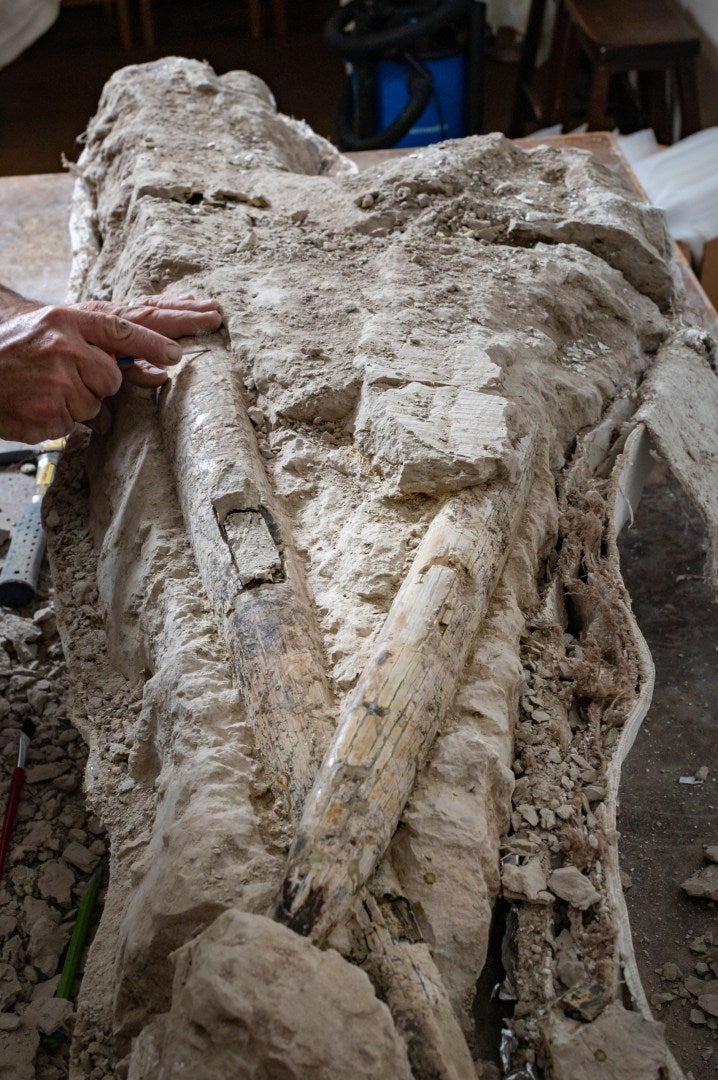First, the trees came out of the ground. A few weeks later, the bones emerged. Bit by bit over the past year, a team of paleontologists and geologists, among others, have uncovered the fossilised remains of a Miocene forest, from its gomphotheres and mastodons to the trees themselves.
A park ranger, Greg Francek, stumbled upon the site last summer. It lies east of San Francisco, near what is today the Mokelumne River. “I was on patrol out on the watershed and I happened upon a petrified tree,” Francek said in a statement put out by the East Bay Municipal Utility District. “After finding dozens of trees, I began to realise that what I was looking at was the petrified remains of a forest.” Further excavations over the following weeks yielded bones, and a stratigraphic autopsy commenced.
The full array of animals found at the site is staggering. Rock on the site is from the Miocene, an epoch relatively recent in deep time (23 million to 5 million years ago) that featured animals fairly similar to many found today. Miocene forests boasted horse ancestors, cousins of modern rhinos, gomphotheres (like elephants, with twice as many tusks), enormous 181 kg salmon progenitors, and giraffe-sized camels, among other creatures. Mammalian megafauna were thriving, and the fortuitous finds at Mokelumne reveal a great swath of that biodiversity.

It’s hard to say what caused the demise of the animals found there, whether one fate doomed them all or they all had personal crises around the same time. According to Russell Shapiro, a palaeontologist at California State University, Chico who has been excavating the site, the fossils come from two types of rock. Some is volcanic mud flow, and the rest is river sediment. It’s possible that the animals were buried in a mudslide, Shapiro said, but more inspection of the bones and geological mapping of the site will be needed for an accurate forensic unpacking.
“This preservation is not uncommon around volcanoes,” Shapiro said in an email. “The muddy sediments entomb the animals and plants so other critters can’t degrade them so easily. What is unique is the sheer volume, as well as the fact that this site is new to science.”
Shapiro said that roughly several hundred vertebrate fossils and at least 500 fossilised trees have been found so far. The site, in other words, is huge — one couldn’t ask for a diorama that better displays the paleoenvironment and its denizens. Among the fossils they’ve turned up are camel toe bones and mastodon tusks, as well as the remains of a giant salmon ancestor and prehistoric tapirs and rhinoceroses. (Before the last Ice Age thawed, North America swarmed with big mammals. Hornless rhinos roamed from Florida to California, as did mammoths and giant ground sloths, but many of these creatures disappeared from North America. Some that headed to South America stuck around a little longer, a migration known as the Great American Biotic Interchange.) The team had to bring in a backhoe to lift some of the larger pieces, like the mastodon tusks, which were estimated to be 8 million years old. Though dating has yet to be rendered on the other fossils, if the animals were killed off in a mudslide, they’d be from the same time.
With a site of such scale — containing a veritable bevy of beasts — it goes without saying that we must be patient. Though members of the public can’t head out to the site to check things out, fossils from the dig are set to be exhibited at CSU, Chico’s Gateway Science Museum in September, along with some ancient whale and ichthyosaur fossils from another site in California. If you can’t wait, visitors are allowed to observe fossil conservators and researchers work on the bones in the university’s lab every Friday and Saturday.
“We find more fossils each time we go out,” Shapiro said. “The real science could literally take decades.” So for every week you don’t go see these bones, there’s the likelihood that a new batch of them will be dug out and added to this incredible assemblage.
